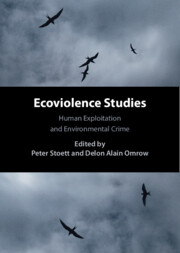Book contents
- Ecoviolence Studies
- Ecoviolence Studies
- Copyright page
- Contents
- Contributors
- Foreword
- Foreword
- Preface and Acknowledgments
- 1 Ecoviolence Studies and Human Security
- 2 The Links between Human Trafficking and Wildlife Trafficking
- 3 Preventing a Secondary Disaster: How Emergency Management Agencies Can Prepare and Respond to Disaster-Linked Exploitation
- 4 Ecoviolence at Sea
- 5 There Will Be Blood: The Return of the Frontier Logic in Guyana and Hyper-Exploitation in the Mining Sector
- 6 Artisanal Gold Mining in Uganda: Towards Formalization as Remediation of Dignity and Rights
- 7 Searching for Shelter in the Climate Crisis Era: Ecocide and Migration
- 8 Climate Change, Violence and Ecocide
- 9 Sea of Cortez Region: Crime and Ecosystem Crossroads
- 10 Minority Languages as Collateral Damage in the Climate Crisis: The Incidental Result of Ecoviolence on Y Gymraeg/Welsh Language
- Index
- References
1 - Ecoviolence Studies and Human Security
Published online by Cambridge University Press: 13 February 2025
- Ecoviolence Studies
- Ecoviolence Studies
- Copyright page
- Contents
- Contributors
- Foreword
- Foreword
- Preface and Acknowledgments
- 1 Ecoviolence Studies and Human Security
- 2 The Links between Human Trafficking and Wildlife Trafficking
- 3 Preventing a Secondary Disaster: How Emergency Management Agencies Can Prepare and Respond to Disaster-Linked Exploitation
- 4 Ecoviolence at Sea
- 5 There Will Be Blood: The Return of the Frontier Logic in Guyana and Hyper-Exploitation in the Mining Sector
- 6 Artisanal Gold Mining in Uganda: Towards Formalization as Remediation of Dignity and Rights
- 7 Searching for Shelter in the Climate Crisis Era: Ecocide and Migration
- 8 Climate Change, Violence and Ecocide
- 9 Sea of Cortez Region: Crime and Ecosystem Crossroads
- 10 Minority Languages as Collateral Damage in the Climate Crisis: The Incidental Result of Ecoviolence on Y Gymraeg/Welsh Language
- Index
- References
Summary
Building on a recent publication (Stoett & Omrow, 2021) this edited volume is intended primarily as a contribution to the evolving field that we will refer to as ecoviolence studies. The field covers a wide variety of themes, challenges, questions, issues, policy designs, and theoretical implications. While the term ecoviolence had gained some popularity in a limited fashion in the 1980s and 1990s, referring primarily to violence that erupts over conflicts related to natural resources – in particular, access to resources contested along sectarian grounds – we use it in much broader fashion and argue that its resurgence as a field of social science is as timely as it is unfortunate. The threats to planetary health that animate activists and state diplomats alike today – the interconnected climate, biodiversity, and pollution crises, amongst other manifestations of modern capitalism and colonial histories as well as contemporary paths to violence – are violent affairs.
- Type
- Chapter
- Information
- Ecoviolence StudiesHuman Exploitation and Environmental Crime, pp. 1 - 20Publisher: Cambridge University PressPrint publication year: 2025

